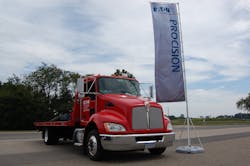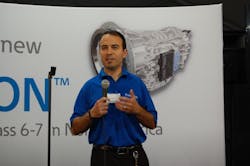The introduction of Eaton Corp.’s new Procision dual clutch transmission this week aims to address what the company believes are the intensification of strategic shifts now occurring in the way North American Class 6-7 medium-duty trucks operate.
Joseph Semaan, Eaton’s director of the global market segment, explained during a press event held at the company’s Marshall Proving Grounds in central Michigan, that shorter distances and slower driving speeds combined with higher amounts of start-stop activity on more congested city and suburb street networks is beginning to become the dominant operating environment for medium-duty units, particularly in the U.S.
[To view more photos of Eaton’s Procision event, click here and here.]For example, he noted that when Eaton rolls out its Procision in mid-2015, it will be available first in the pickup & delivery, towing & recovery, school bus, straight beverage truck and school bus segments – just four applications out of an estimated 200 medium-duty vocations, but four representing about 70% of the 70,000 or so medium-duty units sold in the U.S. annually, Semaan (seen at right) emphasized.
“The critical nuances for those segments are maneuvering in tight areas, travelling on crowded urban roads, plus a lot of stopping, starting, and parking to load and unload,” he pointed out. “This is a very hectic environment that puts more pressure on reliability, safety, ease of operation, fuel economy, and driver comfort.”
It’s that demand for more urban-focused logistics and trucking services that’s driving such changes within the medium-duty market, argued Sandeep Kar global director of commercial vehicle research for consulting firm Frost & Sullivan, in a speech during the North American 3PL Summit hosted by the networking group eyefortransport last year.
“Urban logistics is already bringing about noticeable changes in commercial vehicle design, development and preferences,” he explained. “Trucks are cubing out before weighing out, telematics and connectivity are becoming more ubiquitous, time and mission critical deliveries are on the rise. Moreover, we see a world where 60% of the global population will be living in urban centers by 2025, demanding unique value propositions such as same day service.”
Some of the big “mega trends” Kar believes will reshape the logistics and trucking sectors include: Urbanization; faster growth in “bricks and clicks” consumer goods structures; access to multi-modality; connectivity and convergence; duture infrastructure development focused on meeting higher demand for time-sensitive deliveries
Archana Amarnath, Frost & Sullivan’s program manager, further argued that big money will be attached to those trends, aswell.
“Global spending on urban logistics is expected to grow rapidly from $2.5 trillion in 2011 to nearly $6 trillion by 2020 driven by B2C [business-to-consumer] ecommerce growth, rapid urbanization, and investment in sophisticated technology for better optimization,” Amarnath explained.
“This market opportunity has already attracted many logistics service providers who are introducing innovative business models in urban distribution and last mile operations such as urban consolidation centers, self-collection locker boxes, same-day deliveries, and click and collect,” he added.
What does that all mean for medium-duty trucks? Eaton’s Semaan said that a greater focus on lower total cost of operation (TCO) is going to be one trend that will pick up speed. A few others uncovered by Eaton’s customer research include:
- Expected five to 10 year truck ownership cycle
- Total annual operating miles ranging between 20,000 and 60,000 per year
- Per unit base prices hovering between $60,000 and $80,000
- Longer maintenance intervals with less downtime for repairs
Some of those metrics may shift depending on the particulars of the medium-duty operation, Semann stressed. For example, in the school bus segment, annual mileage totals between 5,000 and 12,000 miles per year. Thus or fleets at the 12,000 mile end of the scale, fuel economy will be a more critical factor compared to those at the 5,000 mile end.
Jeff Carpenter, engineering manager for Eaton’s Procision, noted that the TCO calculations in the medium-duty segment are one reason why the company built its new gearbox with an expected “B10” life of 400,000 miles, with a service interval of 150,000 miles or every three to four years.
“Cost of ownership is really proving to be the biggest driver within the medium-duty market,” he explained, noting in particular that achieving better fuel economy – a major TCO factor – at slower speeds is one of the reasons why Eaton went with a dual clutch platform for its Procision transmission. “Lower TCO at the end of the day is what fleets want.”
About the Author
Sean Kilcarr
Editor in Chief
Sean Kilcarr is a former longtime FleetOwner senior editor who wrote for the publication from 2000 to 2018. He served as editor-in-chief from 2017 to 2018.

